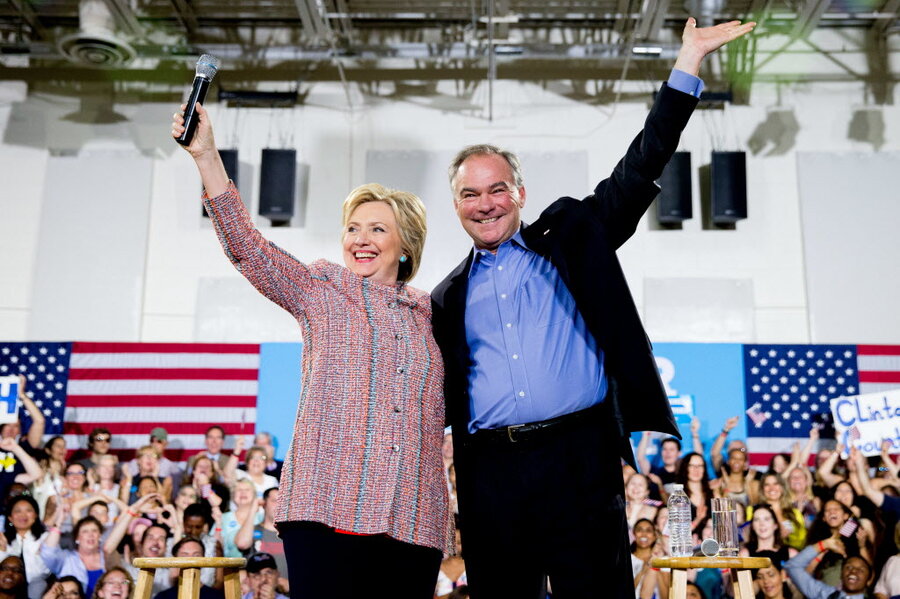Tim Kaine's tax record reflects Clinton's present and possibly future
Loading...
Tim Kaine, Hillary Clinton’s choice for vice president, served as governor of Virginia from 2006 to 2010 (the state has a one-term limit). During his four years, Kaine proposed tax hikes to pay for new government programs and tax cuts for low- and middle-income residents. It’s a combination that closely parallels Clinton’s tax proposals for the nation. However, political opposition in his state legislature derailed Kaine’s larger ambitions and forced him to settle for smaller changes.
Kaine’s big goal was raising taxes to pay for new transportation spending. He asked the Virginia legislature in 2006, 2007, and 2008 for a mix of tax hikes on car sales, auto insurance premiums, and driver fines. And each time the legislature rejected his ideas in favor of debt financing and transfers from the general fund.
Broadly, Kaine’s preference for raising taxes to fund road and transit projects is similar to Clinton’s plan to fund education and infrastructure spending with new taxes. But there is one big difference: Kaine proposed tax hikes that would have affected most Virginians while Clinton would target only the most wealthy Americans.
As governor, Kaine was not a one-note act on taxes. He also advocated several tax-relief measures. In 2007, Kaine and the legislature raised Virginia’s income tax filing threshold from roughly $7,000 to $12,000 for individuals and from $14,000 to $24,000 for married filers, taking more than 300,000 Virginians off the tax rolls. The bill also raised Virginia’s personal exemption from $900 to $930, a Kaine accomplishment that mirrors Donald Trump’s idea to raise the standard deduction (though on a much smaller scale). By contrast, Clinton would leave overall taxes roughly unchanged for middle-income households, though she’s promised to deliver a tax cut for low- and middle-income Americans later in the campaign.
Kaine also signed three sales tax holidays into law: one for back-to-school supplies, one for energy-efficient products, and another for hurricane-preparation gear. These brief periods of tax-free shopping are popular with politicians and voters, but don’t actually benefit most shoppers. (All are still in effect, though the state recently combined all three into one weekend.)
In a move that goes against the Democratic grain, Kaine also backed repeal of Virginia’s estate tax. While Trump wants to kill the federal levy, Kaine’s top of the ticket running mate would boost the national estate tax.
Governor Kaine failed at two other major tax changes. During his 2005 campaign and throughout his administration he pushed for a homestead deduction that would have delivered a 20 percent property tax rebate to homeowners. However, Republicans in the legislature scuttled the plan, afraid it would lead to tax hikes on commercial property. And in one of his final acts as governor, Kaine’s proposed 2010-2012 budget would have hiked the state’s top income tax rate from 5.75 percent to 6.75 percent. His idea was to swap the state’s regressive personal property car tax for a progressive income tax hike mostly aimed at wealthier Virginias. However, after the term-limited Kaine left office, his Republican successor dropped the proposal.
Finally, as you hear stories about Kaine’s successes or failures as governor of Virginia, keep in mind that state chief executives have a relatively limited impact on their economies. This is as true for Kaine as for Trump’s running mate, Indiana Governor Mike Pence. For example, Virginia’s unemployment rate was below the national average during Kaine’s tenure—as it’s consistently been for decades.
So stick with his policy decisions. Kaine was not afraid to propose both tax hikes and tax cuts as governor. He cut deals with his political opposition but was also stonewalled on major proposals (unsurprisingly, tax cuts were easier to pass than tax hikes). Given ongoing gridlock on Capitol Hill, his experience could prove useful if a future Congress tries to cherry-pick ideas from Clinton’s grab bag of tax proposals.
This story originally appeared on TaxVox.







